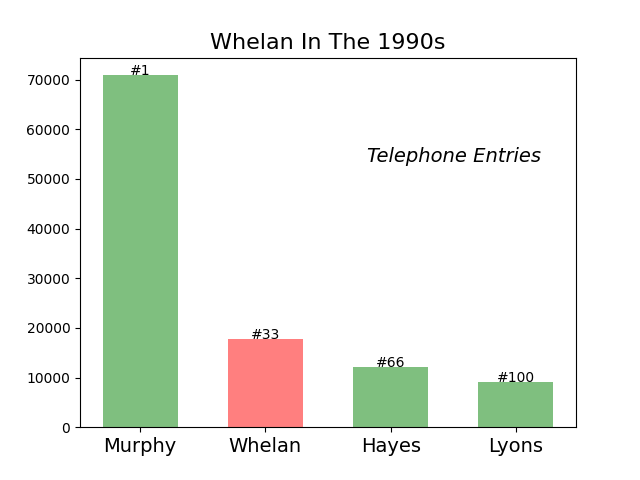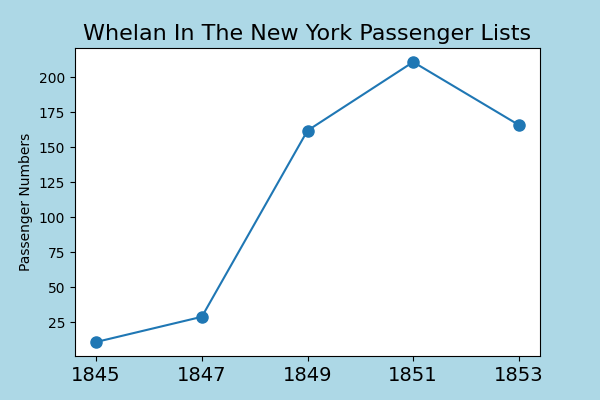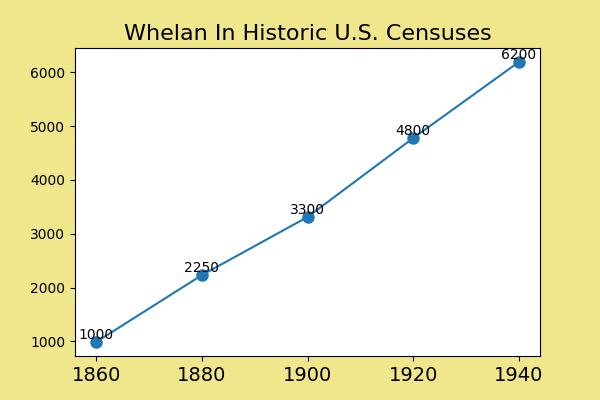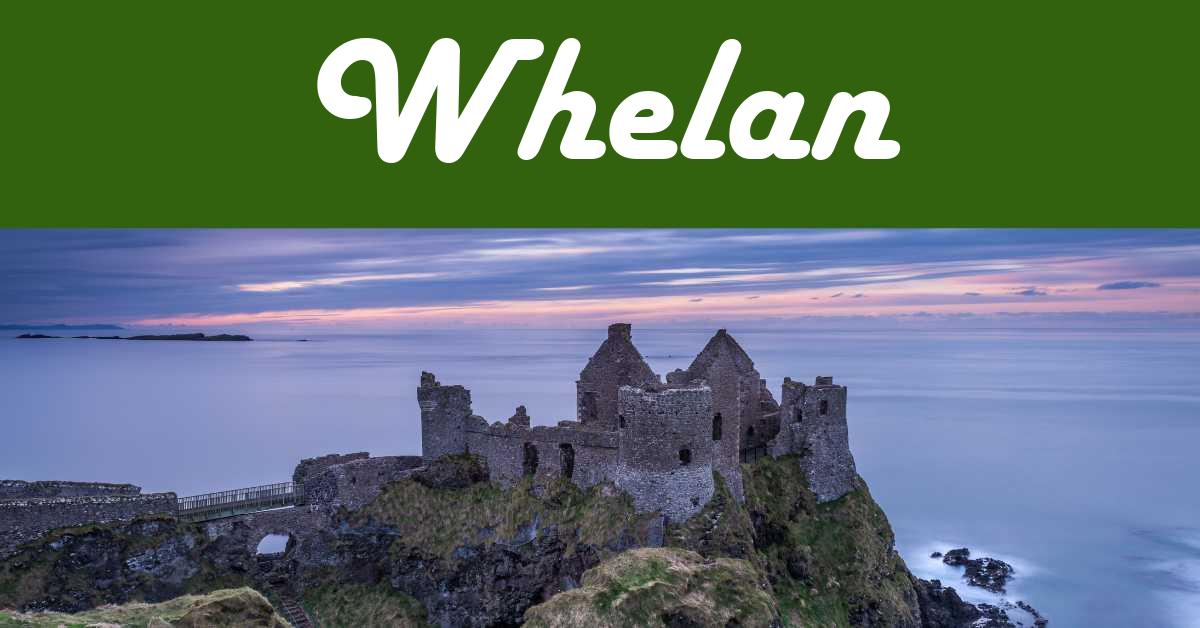This article looks at how common Whelan is as a last name in Ireland and the United States from the 19th century to the present day.
You’ll learn the meaning and origins of the Whelan surname while exploring some notable and famous people that held it.
I use census records, emigration lists, and military archives to uncover fascinating patterns. If you’re studying your genealogy, check out my sources at the end of the post so you can do your own research.
How Common Is Whelan As A Surname In Ireland?
Ireland does not disclose current statistics on surnames in much detail. The most that we get is the top ten last names in birth registrations for the previous year. Whelan
However, an Irish genealogist studied the top one hundred surname numbers in Ireland between 1992 and 1997. Seán Murphy based his research on telephone books. This isn’t as accurate as a census but gives a good approximation.
Whelan was ranked 33 in the top one hundred names in this decade with a total of 17,700 entries.
This graphic shows how it ranks compared to the 1st, 33rd, 66th, and 100th entries in the survey:

Whelan In The Early 1900s
Only the full censuses from 1911 and 1901 in Ireland are available to the public. Earlier decades were either destroyed by the government (to make room for more storage) or by a huge fire during the Irish Civil War. Later decades are unavailable under privacy laws.
Some records exist from earlier censuses, but most of the documents are lost to history. So, we’ll focus on the turn of the century.
I used online archives to calculate the total numbers by surname. I consider these estimates due to some percentage of transcription errors. So, I’ve rounded the numbers to the nearest fifty.
There were 5,950 residents named Whelan on the island in 1911.
Ten years earlier, Whelan had about 8,150 residents in the 1901 census.
Population Estimates In The 1890s
A study of Irish surnames was conducted in 1890 by the head of the Civil Registrations Office. It was published as a “Special Report on Surnames In Ireland.”
The survey estimated that there were about 9,500 people named Whelan in the country.
Emigration To America After The Irish Famine
The Irish have traditionally emigrated to Britain, the U.S., Canada, and Australia in recent centuries. They were driven by various factors like political upheaval, scarcity of work, and food deprivation.
The largest wave of emigration to the United States occurred during the 19th century. The peak was in response to the Great Irish Famine, which took place between 1845 and 1852. A plant disease devastated the main food and income crop for much of the population.
I reviewed the Whelan name in the shipping passenger lists arriving in New York during this period. The departures were from both Ireland and England.
This picture shows how the numbers rose and fell in the years after the famine:

How Common Is Whelan As A Last Name In The U.S.?
Based on the 2010 U.S. census, the name Whelan ranks about 3,974 among Irish names in America with 11,363 bearers.
Although the 2010 census has exact numbers and rankings, the rank I assign here is my estimate. If you’re curious about how I got there, here’s a brief explanation…
Estimating Rank In The United States
Historically, some Irish families with Gaelic surnames took English-sounding names as translations under the influence of colonization.
As these names also have English origins, they will have been brought to the United States by both British and Irish immigrants. Because the census doesn’t ask about specific European origin (e.g. England vs Ireland), it’s impossible to identify the proportion with Irish heritage.
I reviewed the census to identify which names are predominantly Irish in origin. In order to estimate the relative rankings of “Irish” names, I’ve mostly excluded surnames that have varying origins.
Whelan In Historic Times
In a country as young as the United States, tracking the popularity of a surname over time can be fascinating. This reflects other demographic shifts across the country in addition to immigration. Higher child mortality rates and longer life expectancy are just two factors.
The historic census records have been transcribed and digitized. I used online archives to run counts of surname populations.
But the totals can’t be exactly accurate due to transcription errors. So, I’ve rounded the numbers to the nearest 50 in the graph below.
This picture shows the numbers every twenty years from 1860 to 1940:

These are the numbers in the graph:
- 1860: 1,000
- 1880: 2,250
- 1900: 3,300
- 1920: 4,800
- 1940: 6,200
Whelan In World War II
About 8.3 million men and women enlisted in the U.S. Army during the Second World War. Many were of Irish heritage, and some were born in Ireland.
There were registration records for 359 soldiers named Whelan who enlisted between 1938 and 1946.
There were 9 who were born in Ireland.
Whelan Surname: Meaning And Origin
Whelan comes from the Gaelic name Ó Faoláin, which means “descendant of Faolán.”
The personal name Faolán is a diminutive (pet) form of “faol”, which means wolf in Gaelic. So, the name is akin to “descendant of the little wolf.”
One early influential family had a stronghold at Magh Lacha, a plain in Kells in what is now County Kilkenny. They spread from there throughout Lieinser.
Famous Or Historic People Named Whelan
Here are some notable people with the family name:
- Patrick James Whelan (1840 – 1869): emigrated from Galway to Canada where he worked as a tailor. He was executed in a politically charged trial for the assassination of Thomas D’Arcy McGee, which Whelan denied to his dying breath.
- Máire Whelan (1956 – ): first woman to be appointed Attorney General in the Republic of Ireland.
Sources

External Research
The Ireland 1990s estimates are from Seán J. Murphy’s research paper.
The population estimates of 1890 are based on the “Special Report on Surnames in Ireland“, published in 1909.
The population figures for the 2010 U.S. Census come from a file provided by the U.S. Census Bureau.
Internal Research
Some of the population numbers are based on my own research and calculations using online archives. I’ve rounded those numbers to the nearest 50 to account for transcription errors and other technical issues with online databases of this type.
The Irish census estimates for 1901 and 1911 are my calculations based on the Irish National Archives
I plotted the emigration figures from 1845 to 1854 based on calculations from the archives of the New York Passenger Lists (1820-1957).